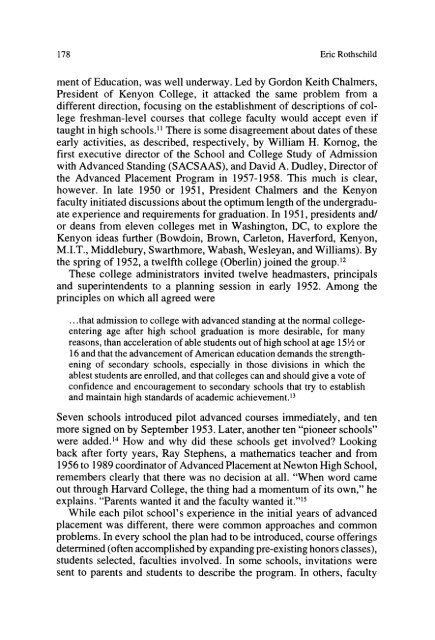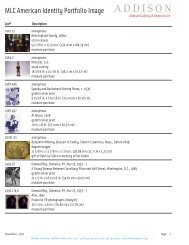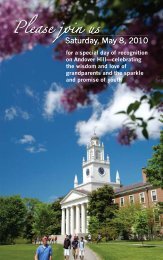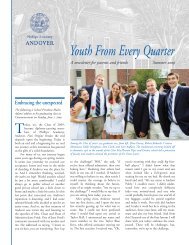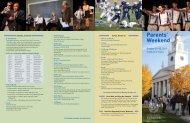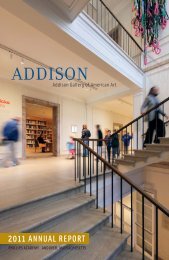Four Decades of the Advanced Placement Program
Four Decades of the Advanced Placement Program
Four Decades of the Advanced Placement Program
Create successful ePaper yourself
Turn your PDF publications into a flip-book with our unique Google optimized e-Paper software.
178 Eric Rothschild<br />
ment <strong>of</strong> Education, was well underway. Led by Gordon Keith Chalmers,<br />
President <strong>of</strong> Kenyon College, it attacked <strong>the</strong> same problem from a<br />
different direction, focusing on <strong>the</strong> establishment <strong>of</strong> descriptions <strong>of</strong> college<br />
freshman-level courses that college faculty would accept even if<br />
taught in high schools.11 There is some disagreement about dates <strong>of</strong> <strong>the</strong>se<br />
early activities, as described, respectively, by William H. Kornog, <strong>the</strong><br />
first executive director <strong>of</strong> <strong>the</strong> School and College Study <strong>of</strong> Admission<br />
with <strong>Advanced</strong> Standing (SACSAAS), and David A. Dudley, Director <strong>of</strong><br />
<strong>the</strong> <strong>Advanced</strong> <strong>Placement</strong> <strong>Program</strong> in 1957-1958. This much is clear,<br />
however. In late 1950 or 1951, President Chalmers and <strong>the</strong> Kenyon<br />
faculty initiated discussions about <strong>the</strong> optimum length <strong>of</strong> <strong>the</strong> undergraduate<br />
experience and requirements for graduation. In 1951, presidents and/<br />
or deans from eleven colleges met in Washington, DC, to explore <strong>the</strong><br />
Kenyon ideas fur<strong>the</strong>r (Bowdoin, Brown, Carleton, Haverford, Kenyon,<br />
M.I.T., Middlebury, Swarthmore, Wabash, Wesleyan, and Williams). By<br />
<strong>the</strong> spring <strong>of</strong> 1952, a twelfth college (Oberlin) joined <strong>the</strong> group.12<br />
These college administrators invited twelve headmasters, principals<br />
and superintendents to a planning session in early 1952. Among <strong>the</strong><br />
principles on which all agreed were<br />
...that admission to college with advanced standing at <strong>the</strong> normal collegeentering<br />
age after high school graduation is more desirable, for many<br />
reasons, than acceleration <strong>of</strong> able students out <strong>of</strong> high school at age 15/2 or<br />
16 and that <strong>the</strong> advancement <strong>of</strong> American education demands <strong>the</strong> streng<strong>the</strong>ning<br />
<strong>of</strong> secondary schools, especially in those divisions in which <strong>the</strong><br />
ablest students are enrolled, and that colleges can and should give a vote <strong>of</strong><br />
confidence and encouragement to secondary schools that try to establish<br />
and maintain high standards <strong>of</strong> academic achievement.'3<br />
Seven schools introduced pilot advanced courses immediately, and ten<br />
more signed on by September 1953. Later, ano<strong>the</strong>r ten "pioneer schools"<br />
were added.14 How and why did <strong>the</strong>se schools get involved? Looking<br />
back after forty years, Ray Stephens, a ma<strong>the</strong>matics teacher and from<br />
1956 to 1989 coordinator <strong>of</strong> <strong>Advanced</strong> <strong>Placement</strong> at Newton High School,<br />
remembers clearly that <strong>the</strong>re was no decision at all. "When word came<br />
out through Harvard College, <strong>the</strong> thing had a momentum <strong>of</strong> its own," he<br />
explains. "Parents wanted it and <strong>the</strong> faculty wanted it."'15<br />
While each pilot school's experience in <strong>the</strong> initial years <strong>of</strong> advanced<br />
placement was different, <strong>the</strong>re were common approaches and common<br />
problems. In every school <strong>the</strong> plan had to be introduced, course <strong>of</strong>ferings<br />
determined (<strong>of</strong>ten accomplished by expanding pre-existing honors classes),<br />
students selected, faculties involved. In some schools, invitations were<br />
sent to parents and students to describe <strong>the</strong> program. In o<strong>the</strong>rs, faculty


